Abstract
OBJECTIVE--Extensive IgE serology in occupational or environmental health studies is often hampered by a lack of technical facilities and finance. The use in population studies of relatively simple and inexpensive enzyme immunoassays (EIAs) was therefore evaluated for the assessment of total serum immunoglobulin E (IgE), and of specific IgE reactions with various common (house dust mites, grass and birch pollen, and cat) or occupational (fungal alpha-amylase and rat urinary protein) allergens. METHODS--Total IgE was measured with a sandwich EIA, calibrated with commercially available IgE standards. Reproducibility was studied by testing pooled normal human serum samples in each of a large series of test plates. A panel of 156 children's serum samples with known IgE values was used to compare the assay with other total IgE assays. A previously developed EIA for anti-yeast IgE was adapted for the measurement of IgE reacting with various common and occupational allergens. Binding of IgE to microwells coated with commercially available allergen extracts, or allergen preparations from our own laboratory, was measured with a monoclonal anti-human IgE antibody and subsequent incubations with biotinylated rabbit anti-mouse Ig and avidin-peroxidase. Panels of serum samples from school children (n = 116), bakery workers (n = 126), and laboratory animal workers (n = 52) were used to study sensitivity and specificity, with reference to skin prick tests as the standard, and to compare the EIAs with commercially available test kits. RESULTS--The detection limit of the EIA for total IgE was 0.5-1 kU/l for undiluted serum samples, and the coefficient of variation between assays was less than 15% at serum concentrations between 1 and 150 kU/l. Results obtained with the panel of 156 children's serum samples were strongly correlated (r2 = 0.86) with IgE concentrations measured previously by radioimmunoassay. The results of the EIA for various occupational allergens correlated very well, both qualitatively and quantitatively, with the results of commercial test kits. Sensitivity and specificity of the EIA results as a predictor of skin prick test reactivity towards common allergens (house dust mite, grass pollen, birch pollen, and cat) were remarkably high (> 80%-90%) in the series of 116 children's serum samples. In a population of bakery workers the specificity of the EIAs was also very high (> 90%). The sensitivity was notably lower (30%-70%) in this adult population, which is, however, in agreement with results reported for conventional IgE tests. CONCLUSION--As the costs were estimated to be at least five to 10-fold lower than those of commercial test kits, the EIAs for total and specific IgE may be very useful tools in epidemiological studies of atopic respiratory or other disorders.
Full text
PDF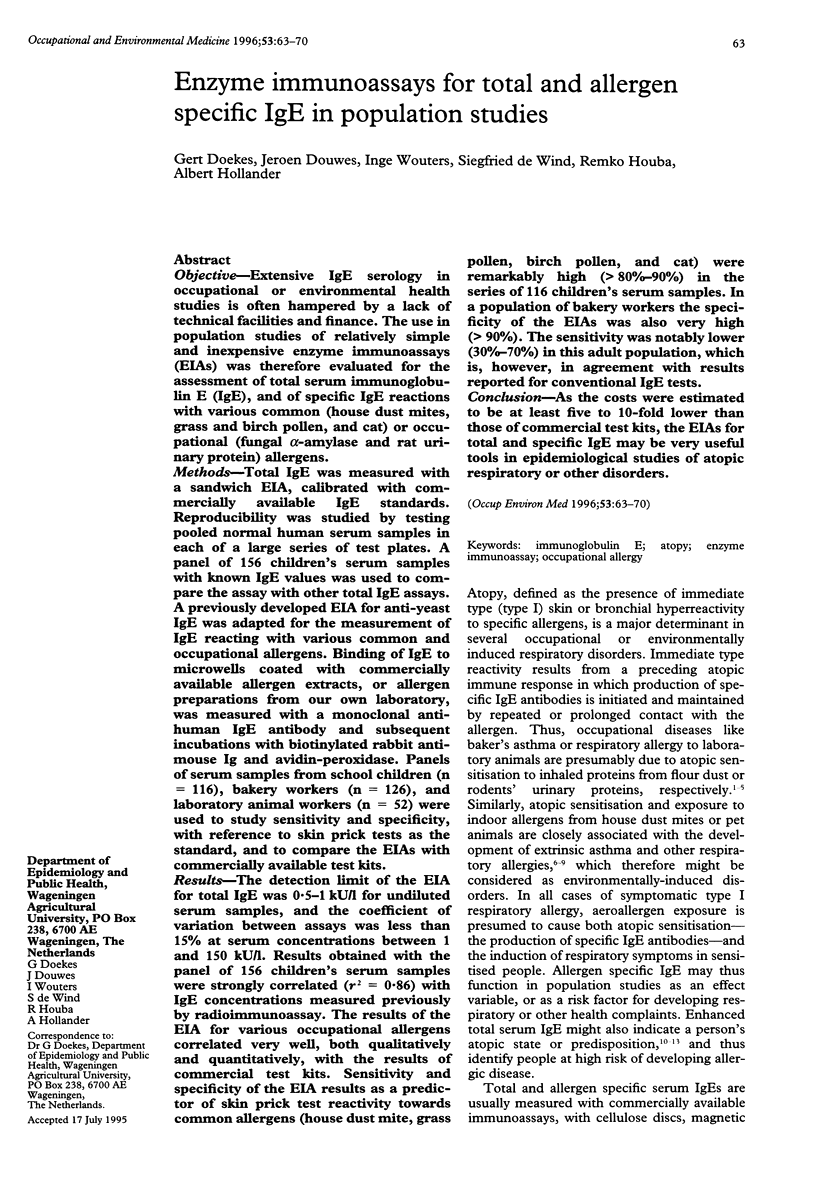
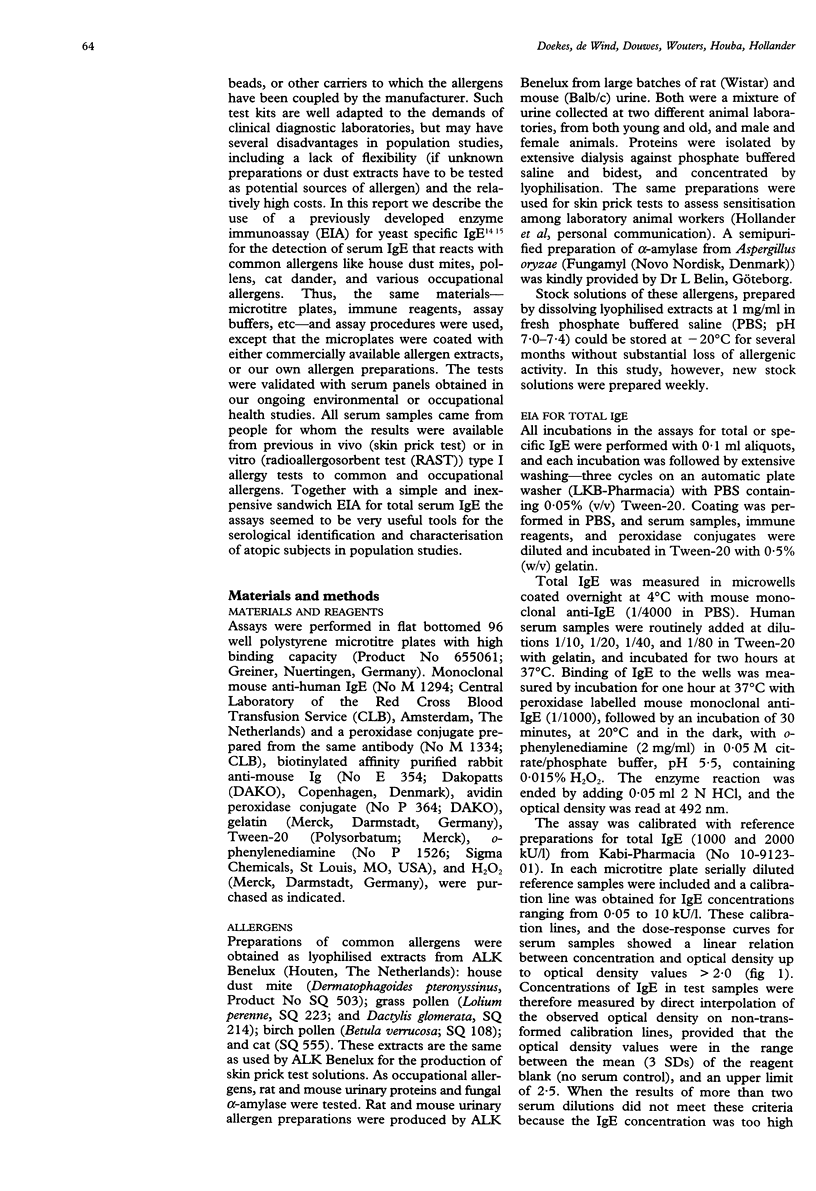
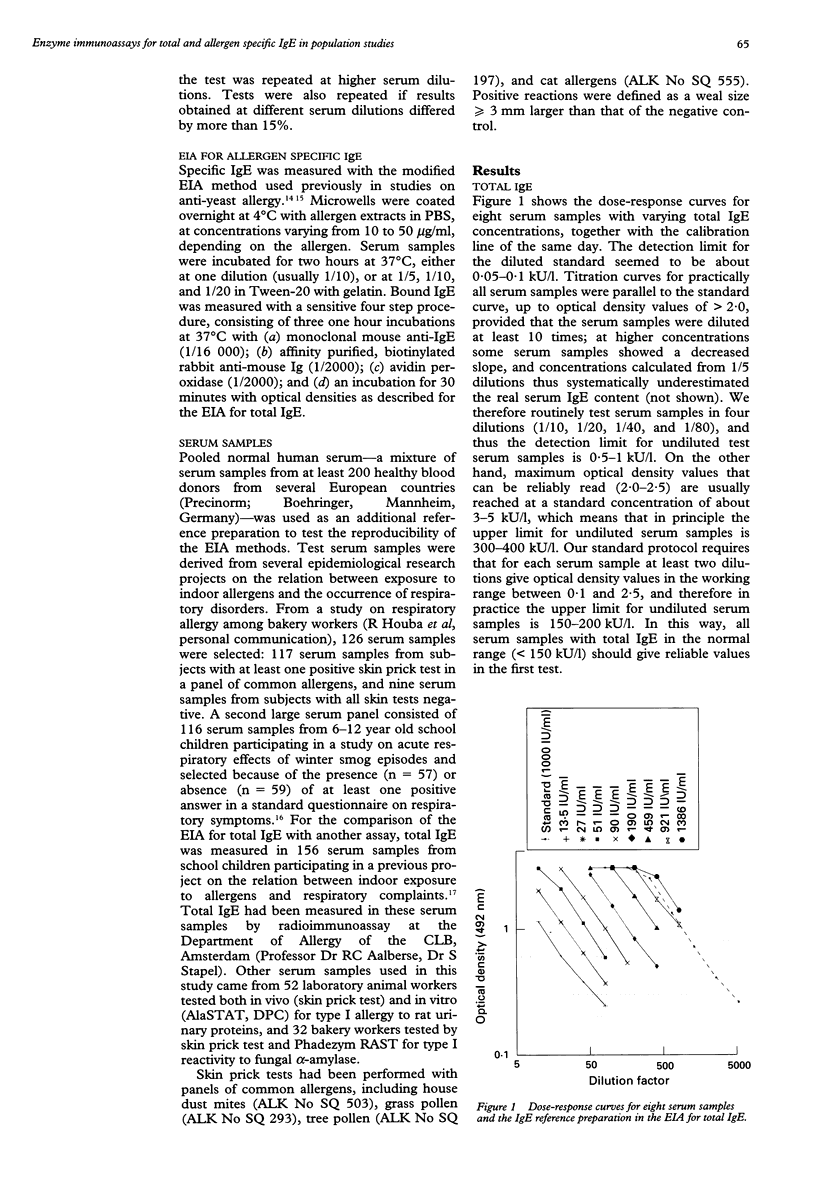
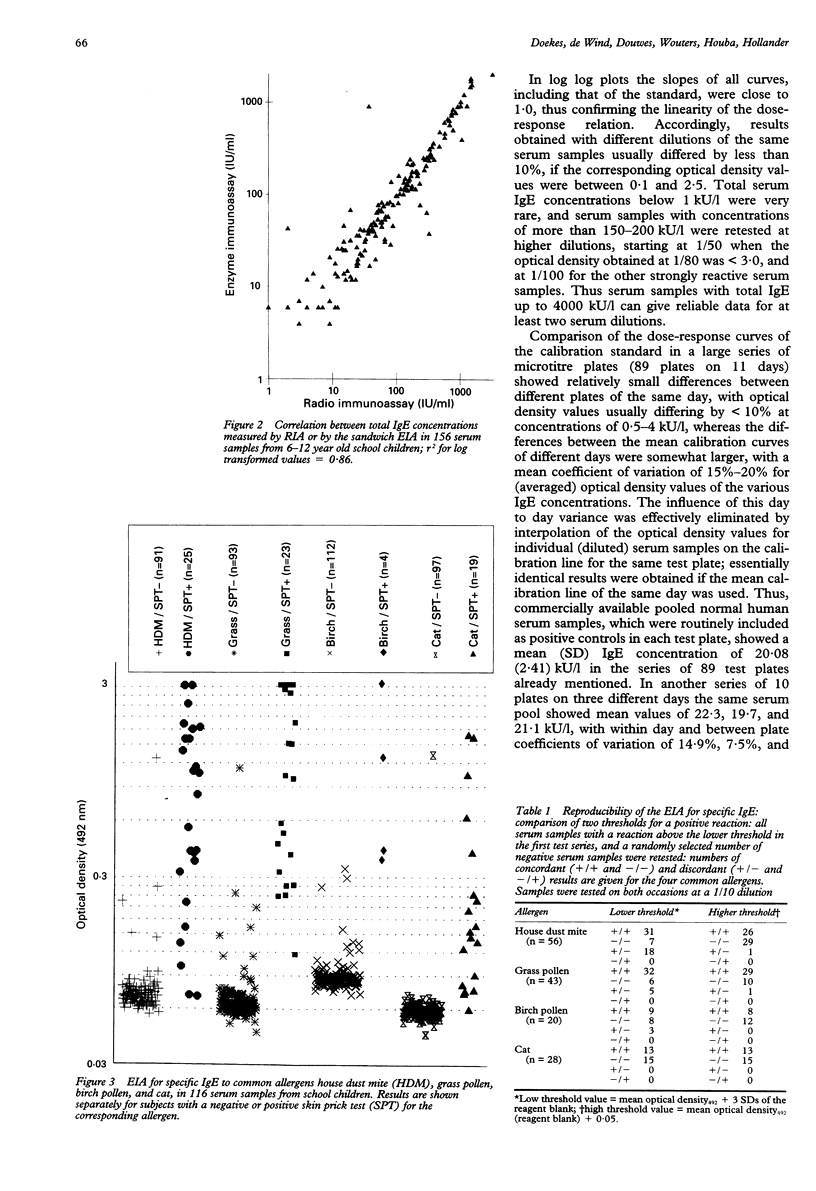

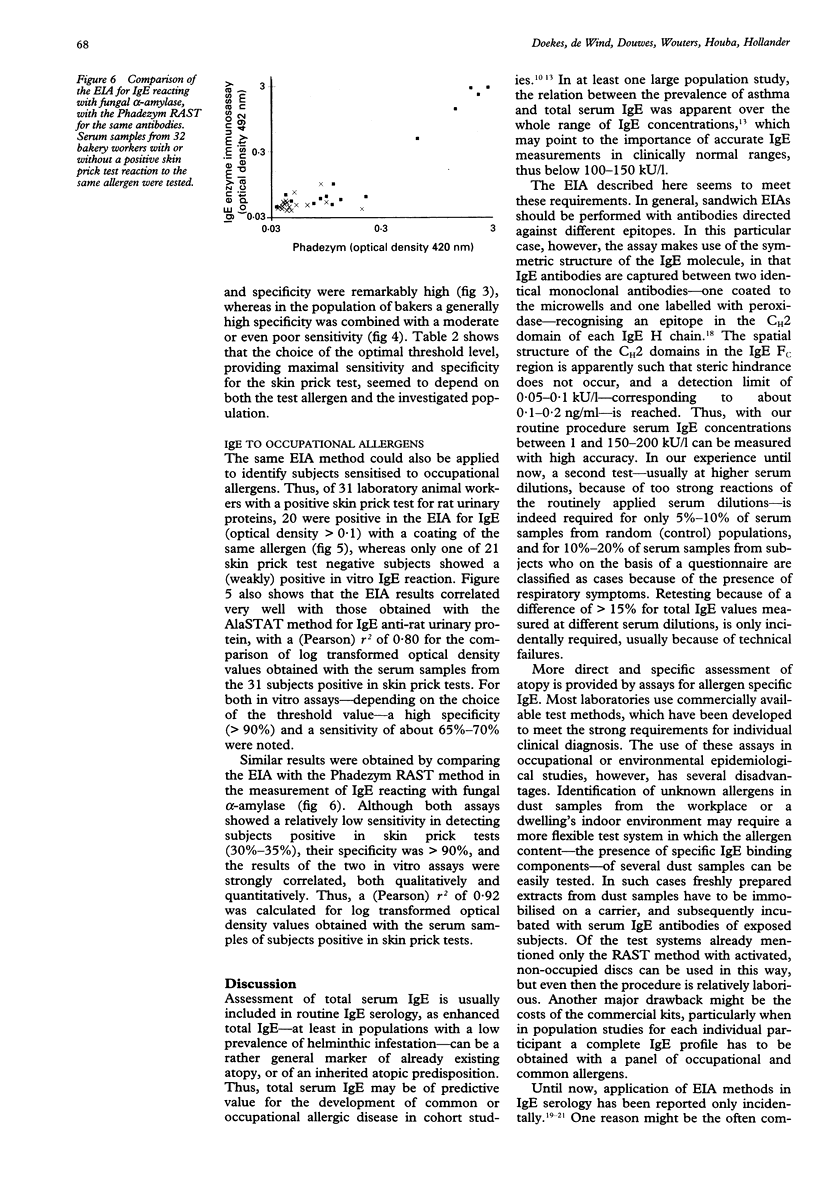
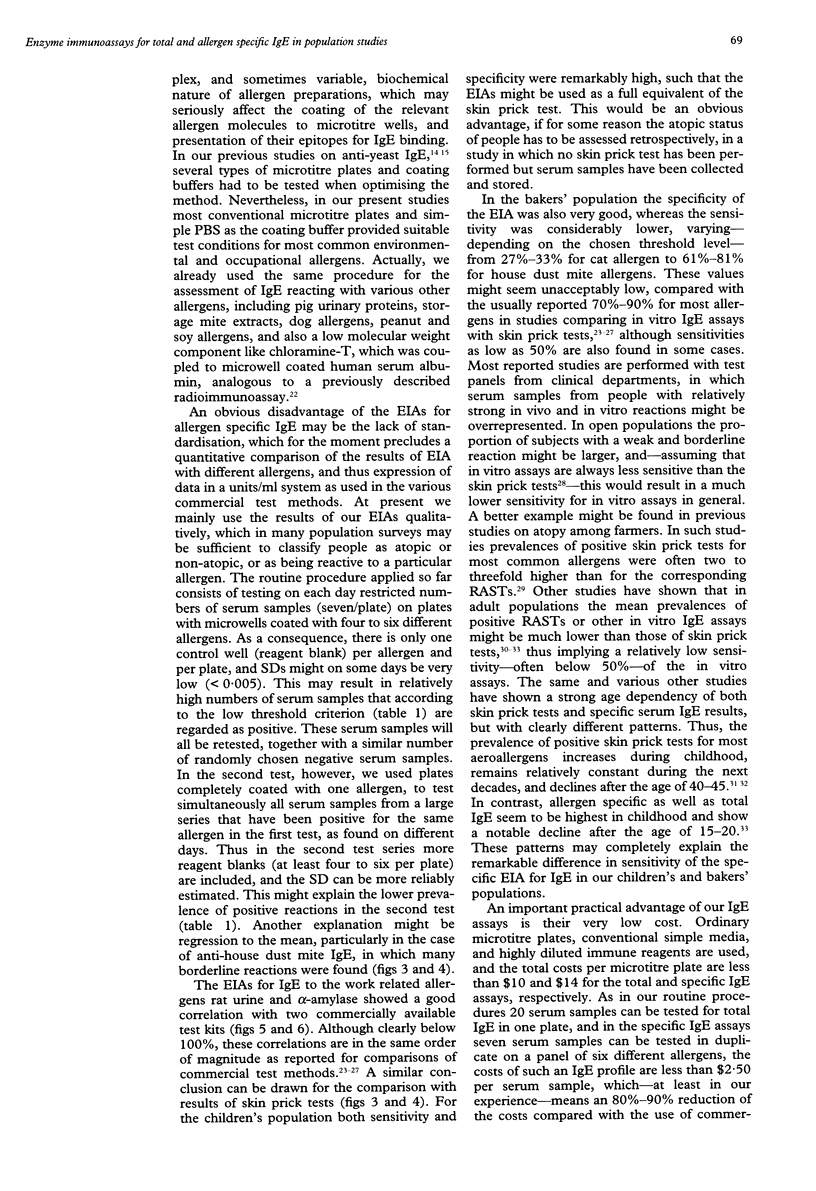

Selected References
These references are in PubMed. This may not be the complete list of references from this article.
- Agata H., Yomo A., Hanashiro Y., Muraki T., Kondo N., Orii T. Comparison of the MAST chemiluminescent assay system with RAST and skin tests in allergic children. Ann Allergy. 1993 Feb;70(2):153–157. [PubMed] [Google Scholar]
- Burrows B., Martinez F. D., Halonen M., Barbee R. A., Cline M. G. Association of asthma with serum IgE levels and skin-test reactivity to allergens. N Engl J Med. 1989 Feb 2;320(5):271–277. doi: 10.1056/NEJM198902023200502. [DOI] [PubMed] [Google Scholar]
- Chan-Yeung M., Malo J. L. Aetiological agents in occupational asthma. Eur Respir J. 1994 Feb;7(2):346–371. doi: 10.1183/09031936.94.07020346. [DOI] [PubMed] [Google Scholar]
- Cline M. G., Burrows B. Distribution of allergy in a population sample residing in Tucson, Arizona. Thorax. 1989 May;44(5):425–431. doi: 10.1136/thx.44.5.425. [DOI] [PMC free article] [PubMed] [Google Scholar]
- Doekes G., van Ieperen-van Dijk A. G. Allergens of Pityrosporum ovale and Candida albicans. I. Cross-reactivity of IgE-binding components. Allergy. 1993 Aug;48(6):394–400. doi: 10.1111/j.1398-9995.1993.tb00736.x. [DOI] [PubMed] [Google Scholar]
- Dust mite allergens and asthma--a worldwide problem. J Allergy Clin Immunol. 1989 Feb;83(2 Pt 1):416–427. doi: 10.1016/0091-6749(89)90128-0. [DOI] [PubMed] [Google Scholar]
- Grundbacher F. J., Massie F. S. Levels of immunoglobulin G, M, A, and E at various ages in allergic and nonallergic black and white individuals. J Allergy Clin Immunol. 1985 Jun;75(6):651–658. doi: 10.1016/0091-6749(85)90089-2. [DOI] [PubMed] [Google Scholar]
- Halonen M., Barbee R. A., Lebowitz M. D., Burrows B. An epidemiologic study of interrelationships of total serum immunoglobulin E, allergy skin-test reactivity, and eosinophilia. J Allergy Clin Immunol. 1982 Feb;69(2):221–228. doi: 10.1016/0091-6749(82)90103-8. [DOI] [PubMed] [Google Scholar]
- Hunskaar S., Fosse R. T. Allergy to laboratory mice and rats: a review of the pathophysiology, epidemiology and clinical aspects. Lab Anim. 1990 Oct;24(4):358–374. doi: 10.1258/002367790780865877. [DOI] [PubMed] [Google Scholar]
- Iversen M., Pedersen B. The prevalence of allergy in Danish farmers. Allergy. 1990 Jul;45(5):347–353. doi: 10.1111/j.1398-9995.1990.tb00510.x. [DOI] [PubMed] [Google Scholar]
- Kelso J. M., Sodhi N., Gosselin V. A., Yunginger J. W. Diagnostic performance characteristics of the standard Phadebas RAST, modified RAST, and pharmacia CAP system versus skin testing. Ann Allergy. 1991 Nov;67(5):511–514. [PubMed] [Google Scholar]
- Kleine-Tebbe J., Eickholt M., Gätjen M., Brunnée T., O'Connor A., Kunkel G. Comparison between MAGIC LITE- and CAP-system: two automated specific IgE antibody assays. Clin Exp Allergy. 1992 Apr;22(4):475–484. doi: 10.1111/j.1365-2222.1992.tb00150.x. [DOI] [PubMed] [Google Scholar]
- Kramps J. A., van Toorenenbergen A. W., Vooren P. H., Dijkman J. H. Occupational asthma due to inhalation of chloramine-T. II. Demonstration of specific IgE antibodies. Int Arch Allergy Appl Immunol. 1981;64(4):428–438. doi: 10.1159/000232723. [DOI] [PubMed] [Google Scholar]
- Magnusson C. G., Aalberse R. C., Johansson S. G. Monoclonal antibodies against human IgE. Identification of a determinant restricted to IgE of the lambda light-chain type. Int Arch Allergy Appl Immunol. 1986;80(3):329–332. [PubMed] [Google Scholar]
- Magnusson C. G. Cord serum IgE in relation to family history and as predictor of atopic disease in early infancy. Allergy. 1988 May;43(4):241–251. doi: 10.1111/j.1398-9995.1988.tb00896.x. [DOI] [PubMed] [Google Scholar]
- Moneret-Vautrin D. A., Halpern G. M., Brignon J. J., Nicolas J. P., Kanny G. Food specific IgE antibodies: a comparative study of AlaSTAT and Pharmacia RAST Phadebas CAP systems in 49 patients with food allergies. Ann Allergy. 1993 Aug;71(2):107–114. [PubMed] [Google Scholar]
- Niemeijer N. R., de Monchy J. G. Age-dependency of sensitization to aero-allergens in asthmatics. Allergy. 1992 Aug;47(4 Pt 2):431–435. doi: 10.1111/j.1398-9995.1992.tb02084.x. [DOI] [PubMed] [Google Scholar]
- Omenaas E., Bakke P., Elsayed S., Hanoa R., Gulsvik A. Total and specific serum IgE levels in adults: relationship to sex, age and environmental factors. Clin Exp Allergy. 1994 Jun;24(6):530–539. doi: 10.1111/j.1365-2222.1994.tb00950.x. [DOI] [PubMed] [Google Scholar]
- Platts-Mills T. A., Ward G. W., Jr, Sporik R., Gelber L. E., Chapman M. D., Heymann P. W. Epidemiology of the relationship between exposure to indoor allergens and asthma. Int Arch Allergy Appl Immunol. 1991;94(1-4):339–345. doi: 10.1159/000235398. [DOI] [PubMed] [Google Scholar]
- Ponder R. D., Stafford C. T., Kiefer C. R., Ford J. L., Thompson W. O., Hoffman D. R. Development of an enzyme-linked immunosorbent assay for measurement of fire ant venom-specific IgE. Ann Allergy. 1994 Apr;72(4):329–332. [PubMed] [Google Scholar]
- Prichard M. G., Ryan G., Walsh B. J., Musk A. W. Skin test and RAST responses to wheat and common allergens and respiratory disease in bakers. Clin Allergy. 1985 Mar;15(2):203–210. doi: 10.1111/j.1365-2222.1985.tb02274.x. [DOI] [PubMed] [Google Scholar]
- Renström A., Malmberg P., Larsson K., Sundblad B. M., Larsson P. H. Prospective study of laboratory-animal allergy: factors predisposing to sensitization and development of allergic symptoms. Allergy. 1994 Aug;49(7):548–552. doi: 10.1111/j.1398-9995.1994.tb01127.x. [DOI] [PubMed] [Google Scholar]
- Sporik R., Chapman M. D., Platts-Mills T. A. House dust mite exposure as a cause of asthma. Clin Exp Allergy. 1992 Oct;22(10):897–906. doi: 10.1111/j.1365-2222.1992.tb02062.x. [DOI] [PubMed] [Google Scholar]
- Subba Rao P. V., McCartney-Francis N. L., Metcalfe D. D. An avidin--biotin microELISA for rapid measurement of total and allergen-specific human IgE. J Immunol Methods. 1983 Feb 25;57(1-3):71–85. doi: 10.1016/0022-1759(83)90066-2. [DOI] [PubMed] [Google Scholar]
- Sutton R., Skerritt J. H., Baldo B. A., Wrigley C. W. The diversity of allergens involved in bakers' asthma. Clin Allergy. 1984 Jan;14(1):93–107. doi: 10.1111/j.1365-2222.1984.tb02196.x. [DOI] [PubMed] [Google Scholar]
- Van Strien R. T., Verhoeff A. P., Brunekreef B., Van Wijnen J. H. Mite antigen in house dust: relationship with different housing characteristics in The Netherlands. Clin Exp Allergy. 1994 Sep;24(9):843–853. doi: 10.1111/j.1365-2222.1994.tb01807.x. [DOI] [PubMed] [Google Scholar]
- Venables K. M., Upton J. L., Hawkins E. R., Tee R. D., Longbottom J. L., Newman Taylor A. J. Smoking, atopy, and laboratory animal allergy. Br J Ind Med. 1988 Oct;45(10):667–671. doi: 10.1136/oem.45.10.667. [DOI] [PMC free article] [PubMed] [Google Scholar]
- Verhoeff A. P., van Strien R. T., van Wijnen J. H., Brunekreef B. Damp housing and childhood respiratory symptoms: the role of sensitization to dust mites and molds. Am J Epidemiol. 1995 Jan 15;141(2):103–110. doi: 10.1093/oxfordjournals.aje.a117398. [DOI] [PubMed] [Google Scholar]
- Wessels M. W., Doekes G., Van Ieperen-Van Kijk A. G., Koers W. J., Young E. IgE antibodies to Pityrosporum ovale in atopic dermatitis. Br J Dermatol. 1991 Sep;125(3):227–232. doi: 10.1111/j.1365-2133.1991.tb14745.x. [DOI] [PubMed] [Google Scholar]
- Wittig H. J., Belloit J., De Fillippi I., Royal G. Age-related serum immunoglobulin E levels in healthy subjects and in patients with allergic disease. J Allergy Clin Immunol. 1980 Oct;66(4):305–313. doi: 10.1016/0091-6749(80)90026-3. [DOI] [PubMed] [Google Scholar]
- van Houte A. J., Bartels P. C. Comparative evaluation of the pharmacia CAP system and the DPC AlaSTAT system for in vitro detection of allergen-specific IgE with the skin prick test. Eur J Clin Chem Clin Biochem. 1992 Feb;30(2):101–105. [PubMed] [Google Scholar]
- van der Zee J. S., de Groot H., van Swieten P., Jansen H. M., Aalberse R. C. Discrepancies between the skin test and IgE antibody assays: study of histamine release, complement activation in vitro, and occurrence of allergen-specific IgG. J Allergy Clin Immunol. 1988 Aug;82(2):270–281. doi: 10.1016/0091-6749(88)91011-1. [DOI] [PubMed] [Google Scholar]


